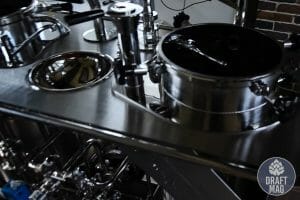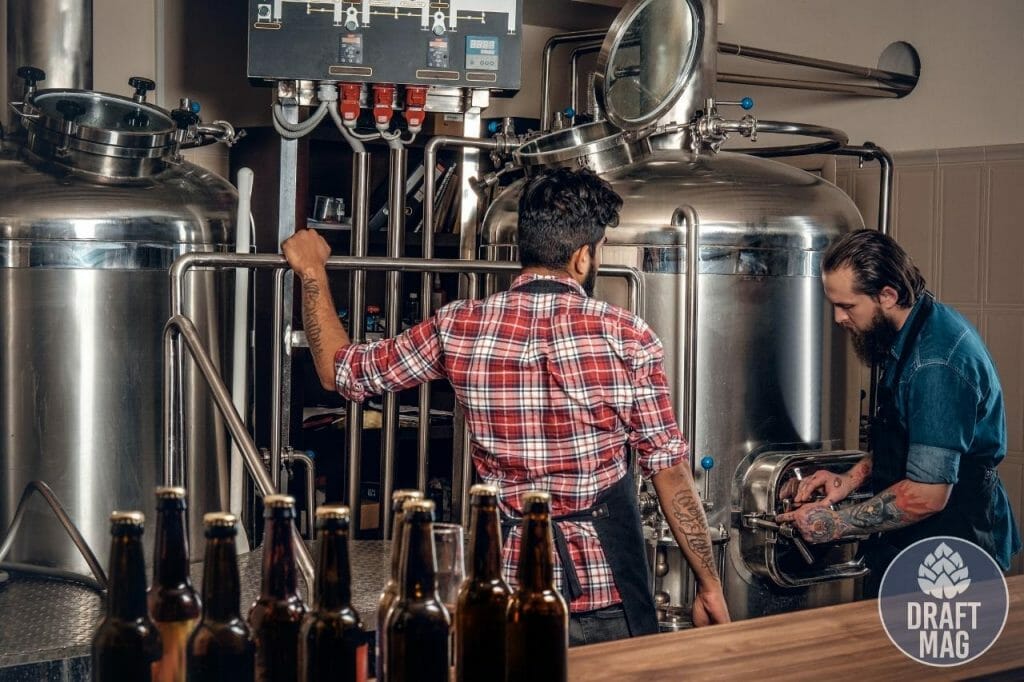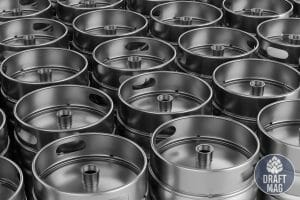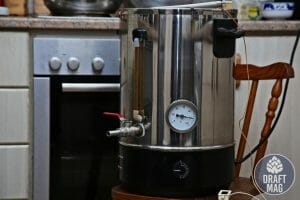Herms vs Rims: Which Home Brewing System Is the Best?
 Herms vs Rims are two of the most popular home brewing systems designed to produce the finest tasting beer at home. Brewing your favorite beer at home is surely fun, but only when you have the right equipment.
Herms vs Rims are two of the most popular home brewing systems designed to produce the finest tasting beer at home. Brewing your favorite beer at home is surely fun, but only when you have the right equipment.
Wondering which one is a better match for you? Don’t worry, Keep reading this article as you will find out whether a Hermes system is best for you or a Rims.
Herms Vs Rims Comparison Table
| Feature | Herms | Rims |
| Heating | Gradual | Fast |
| Portability | Not portable | Portable |
| Usability | Beginner-friendly | Complex |
| Pricing | $4000 to $5000 | $5000 to $10000 |
Herms Vs Rims Comparison
The main difference between Herms and Rims is that Herms fluctuate the heat by turning the pump on and off as required while keeping the source of heat constant. On the other hand, Rims manages the temperature by changing the heat source while the pump remains continuously turned on.
– Heating Speed
Winner: Rims
If you are seeking to find a system that heats up fast, Rims systems are certainly a great choice. In a Rims system, the wort is stored in much smaller chambers, making it easier to heat up. On the other hand, the wort chambers of a Herms brewing system are quite big, and naturally, it takes longer to heat them up.
But at the same time, it’s not about doing it fast but heating the grains evenly, which in that case, Herms is a better choice. The heating is done steadily, extracting the best flavors from the wort. With Rims, on the other hand, you always have to keep a close eye on it, or else the wort might overboil.
– Cleaning
Winner: Herms
Brewing your own beer at home is exciting! But are you equally excited about cleaning the huge system all by yourself? If not, then Herms systems offer a much easier way out. Sure, they too have many tubes, pumps, and vessels but are still much easier to clean than Rims systems which are typically unpopular for their complex build.
To clean a herms system, all that you have to do is elevate the base of the container in a way that it tilts forward, letting the remnants from the brew pass out from the drain. To get to a more thorough cleaning, you can spray down a little water to wash off the wort residue. On the other hand, for better results, you may also use any artificial cleaner and turn on the heat to run the machine.
The cleaning process for a Rims system is also more or less similar. The only difference is there are more things to clean. Also, since the wort in Rims systems is more prone to scorching, you might need to clean harder.
– Control
Winner: Herms
If proper control is one of your top priorities when looking for a home brewing system, Herms is again the clear winner. First of all, it’s super easy to control the temperature rise with a Herms system compared to a Rims system which is known for rapid heating. Secondly, to manage the temperature of a Herms system, all that you have to do is turn the pump on.
– Pricing
Winner: Herms
If you are looking for a brewing system on a budget, go for Herms. A regular Herms model will cost you about $4000 to $5000. On the other hand, even the most basic Rims model can cost anywhere between $5000 to $10000. Keep in mind that since Rims does not bring any extra benefit to the table with the extra price, there is no point in investing those extra dollars.
– Step Mashes
Winner: Herms
 Step mashing is a prominent industrial process where the wort is manipulated through various temperature cycles to help you get the perfect texture and taste. Nonetheless, it’s pretty clear that efficient step mashing requires impeccable control over the temperature. Hence naturally, Herms are a much better choice for step mashing than Rims which might heat the wort faster but are not easy to control.
Step mashing is a prominent industrial process where the wort is manipulated through various temperature cycles to help you get the perfect texture and taste. Nonetheless, it’s pretty clear that efficient step mashing requires impeccable control over the temperature. Hence naturally, Herms are a much better choice for step mashing than Rims which might heat the wort faster but are not easy to control.
Step mashing produces beer of superior quality. It is usually done for grains that require extra treatment to release an adequate amount of fermentable sugar. Step mashing can involve adding multiple rounds of water or simply treating the water under different temperature ranges.
The manual method of heat and crash to mash can be replicated. All that you have to do is increase the temperature of the coil and decrease the span of the mash rests. After that, use a jet of cold water to bring it down to its correct temperature during each mash rest period.
While modern malt grains do not make it necessary to use a step mash, it still gives you better control over the process and the quality of the final product.
– Portability
Winner: Rims
Although home brewing systems are meant to be installed in one place, you might still want to have a relatively portable system. In that case, Rims is a clear winner. Despite having a complex working mechanism, the system itself is pretty compact and easy to carry.
On the other hand, Herms systems come with a bulky hot-liquor tub with or sometimes an external vessel with water to heat up the metal tube. These additional parts make Herms systems much harder to handle, especially if you plan to relocate them.
Herms Review
– Pros
- Beginner-friendly and easy to set up
- No chances of accidentally burning the grains
- Maintaining the temperature is easy and it grows steadily
– Cons
- Not compatible with step-mashing
- The sparge water has to be heated first; which leads to a loss of time and energy
Herms stands for Heat Exchange Recirculating Mash System. The two most significant similarities between a Herms and Rims system is that in both types of equipment, the wort is circulated in every cycle.
In these systems, the wort is pumped from the bottom of the mash, passed through a metal-tube coil, and pushed back to the top. Unlike a Rims system, the metal tube itself isn’t heated here. Instead, the tube is immersed in a hot-liquor tub (HLT). And since the wort is not coming in direct contact with the heat source, it’s less likely to burn.
Also, with Herms systems, you cannot control the heat on the mash directly from the heat source. Instead, you need to manipulate the pump to increase or decrease the temperature. If you want a better grip over the temperature in a Herms system, you can use an electronic controller to control the settings of the pump.
The best thing about a Herms system is that the whole heating process is so smooth and gradual that there is not even the slightest chance of you accidentally burning the grains. The brewing system automatically maintains a steady brewing temperature even if you are not there to monitor it.
Another advantage of using the Herms system is that it’s super simple to set up, clean, and maintain. Even if you are a beginner, it will hardly take you a couple of hours to understand how the system works. Once it’s set up, you don’t have to keep supervising it every second.
Lastly, Herms systems are built to maintain a constant mash temperature with the help of thermal stratification. Under, when two steams at different temperatures meet each other, the cooler steam is allowed to settle at the bottom, whereas the warmer steam rises up, providing the perfect temperature to your wort. Thermal stratification is also known to reduce the pumping energy of the device.
RIMS Review
– Pros
- The whole system heats up pretty quickly
- The final brew is 100 percent clear and transparent; free of residue
- Since the amount of water in a Rims system is low, it’s portable
– Cons
- Too complex for beginners
- The pump needs constant monitoring to prevent the wort from boiling
Rims stands for Recirculating Infusion Mash System. In these types of systems, the wort is continuously circulated. First, it is pulled from the bottom of the mash tun, passed through a heated tube, and then pushed back on the top of the mash.
These systems are best known for the clarity they bring to the final brew. Since the wort is passed through a grain bed for each cycle, there are no remnants or residues left in the final product. These systems also have minimal chances of developing hot spots on the grain bed, which further improves the clarity of the final brew.
Another benefit of working with a Rims system is it allows you to maintain an even temperature throughout the process. Also, you get an inbuilt heat source in the tube, so you don’t have to get an additional insulated mash tun. Increasing the mash temperature with a Rims brewing system is a breeze, and this would be its best feature.
The only downside of using Rims is it’s quite complicated, especially for beginners. Wrapping your head around how it works and then learning to clean it the right way comes with a considerable learning curve.
Rims brewing systems are also infamous for being prone to burning the wort. That is true; since the temperature rises too quickly in a Rims system, it might accidentally over-boil the wort, spoiling the taste of the beer. If you are worried about this, try using a temperature probe to first test the temperature of the heating element before starting the process.
Another major concern surrounding the Rims systems is if they are gas-driven, it can get pretty expensive, especially for propane gas. On the other hand, if you are trying to find a cheaper alternative without switching to a Herms system, simply go for an electric Rims brewing system.
FAQ
– How Does a Herms System Work?
Herms systems work on the principle of heat exchange. They either come with a copper wire immersed in the hot liquor tank (HLT) or another vessel filled with hot water. The mash water goes through the coil, picks up the heat, and returns to the mash lauter tun (MLT). The cycle keeps repeating until the mash begins to break down compounds and ferment the sugar present in the grains to finally produce beer.
– How Long Should Herms Coil Be?
The coil for a Herms system should be at least eight meters long. Only then will it be able to efficiently transfer heat to the mash water. It also depends on the dimensions of the other components of the system. For example, if you choose to go with a bigger HLT, you will naturally need a longer tube. On the other hand, smaller Herms systems can do fine even with tubes shorter than eight meters.
– What Is a Decoction Mash?
If you have been researching brewing your own beer at home, you have probably heard of a decoction mash. It is nothing but a step mashing technique where a portion of the grain is removed, boiled, and then added back to the mash to raise the temperature of the rest of it.
Conclusion
When trying to find the right home brewing system, it’s essential to understand your own expertise and limitations. Herms is clearly a better choice. It’s much easier to use and clean and is equally affordable. However, beginners can work their way through Herms pretty easily and produce fine-tasting beer with minimal hassle.
Rims, on the other hand, is not only costly but also unnecessarily complex. It surely has a more compact structure compared to Herms, but the rest of it comes with a pretty steep learning curve, especially for newbies. Both of these systems ensure that there is no need for manual decoction and that the final product’s flavor remains intact. Both Rims and Herms can produce equally tasteful beers, so no matter which you pick, you will have a great experience.






